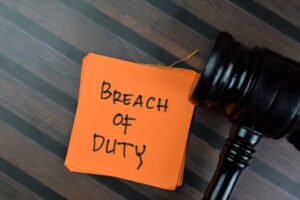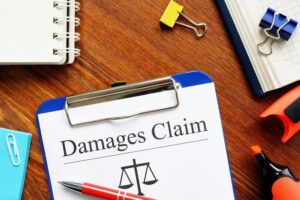When you get hurt because someone else was careless, you may file a personal injury claim to get compensated for your injuries and losses. But proving your injury case often comes down to showing the other party’s negligence.
What is Negligence?
Negligence means that someone failed to use reasonable care that a prudent person would use in the same situation. When negligence leads to an accident causing injury, the negligent party may need to pay for the harm. There are four main elements you must establish to prove negligence in a personal injury case:- The party owed you a duty of care
- The party breached or violated that duty
- The breach caused your injury
- You suffered actual damages
Duty of Care
The first part of proving negligence is showing that the other party owed you a duty of care. This means they had an obligation to act in a reasonably careful way to avoid causing you harm. Some examples of common duties of care include:- Drivers owe a duty to obey traffic laws and drive safely
- Property owners owe a duty to keep premises reasonably safe for visitors
- Manufacturers owe a duty to make products free of defects that could cause injury
- Doctors owe a duty to provide competent medical care, meeting professional standards
Breach of Duty
 The second key element for establishing negligence in a personal injury case is proving the other party breached or violated the duty of care they owed to you.
Simply having a duty is not enough. You must show that the defendant failed to fulfill that duty through specific careless or unreasonable actions or a lack of action entirely. This breach of duty is essentially the negligent conduct that directly led to the accident occurring and your injuries.
There are countless examples of potential duty breaches across different scenarios. In a car accident case, the breach may involve a driver operating their vehicle unsafely or unlawfully.
This includes speeding, running red lights, driving while impaired, texting, or making an improper turn. The negligence is the failure to control the vehicle. It is also the failure to obey traffic laws, as a reasonably prudent driver would.
For premises liability cases like slip and falls at businesses, the breach could be a property owner's failure to properly inspect for hazards, neglect to clean up spills or hazards promptly, providing inadequate lighting or security measures, or failure to warn visitors of hidden dangers on the property that posed unreasonable risks of injury.
In product liability claims, makers, sellers, and distributors can breach duties. They do this by designing unreasonably dangerous or defective products. They can also breach duties by failing to include proper instructions or warning labels, not testing products before releasing them, or using substandard materials that increase risks. The negligence stems from not taking reasonable care to ensure product safety.
Medical malpractice claims frequently involve breaches like surgical errors, misdiagnosis, delays in treatment, improper medication dosages, neglectful patient monitoring, failure to obtain informed consent, and violating established standards of care for treating specific injuries or conditions.
Doctors, nurses, hospitals, and other providers can breach duties through negligent medical judgments or oversight.
No matter the specific scenario, the overarching question in determining a breach of duty is whether the defendant failed to exercise the level of prudent, reasonable care as someone in the same role and under the same circumstances.
The breach does not necessarily have to involve intentional misconduct. It can also arise from careless, inadvertent actions or a failure to take precautions that a reasonable person would.
In evaluating a breach, a jury will likely consider factors like the foreseeable risks and dangers involved, industry guidelines or laws outlining standards of reasonable care, how the defendant's conduct aligned with or deviated from peers in similar situations, and whether precautions within the defendant's control could have prevented the incident.
Expert testimony commonly establishes what qualifies as reasonable, prudent actions for the applicable profession or activity.
If the defendant's actions unreasonably departed from care standards and created an undue risk that led to the plaintiff's injuries, the plaintiff can satisfy the breach element. From there, the plaintiff must demonstrate the remaining causation and damages elements to prove overall negligence liability.
The second key element for establishing negligence in a personal injury case is proving the other party breached or violated the duty of care they owed to you.
Simply having a duty is not enough. You must show that the defendant failed to fulfill that duty through specific careless or unreasonable actions or a lack of action entirely. This breach of duty is essentially the negligent conduct that directly led to the accident occurring and your injuries.
There are countless examples of potential duty breaches across different scenarios. In a car accident case, the breach may involve a driver operating their vehicle unsafely or unlawfully.
This includes speeding, running red lights, driving while impaired, texting, or making an improper turn. The negligence is the failure to control the vehicle. It is also the failure to obey traffic laws, as a reasonably prudent driver would.
For premises liability cases like slip and falls at businesses, the breach could be a property owner's failure to properly inspect for hazards, neglect to clean up spills or hazards promptly, providing inadequate lighting or security measures, or failure to warn visitors of hidden dangers on the property that posed unreasonable risks of injury.
In product liability claims, makers, sellers, and distributors can breach duties. They do this by designing unreasonably dangerous or defective products. They can also breach duties by failing to include proper instructions or warning labels, not testing products before releasing them, or using substandard materials that increase risks. The negligence stems from not taking reasonable care to ensure product safety.
Medical malpractice claims frequently involve breaches like surgical errors, misdiagnosis, delays in treatment, improper medication dosages, neglectful patient monitoring, failure to obtain informed consent, and violating established standards of care for treating specific injuries or conditions.
Doctors, nurses, hospitals, and other providers can breach duties through negligent medical judgments or oversight.
No matter the specific scenario, the overarching question in determining a breach of duty is whether the defendant failed to exercise the level of prudent, reasonable care as someone in the same role and under the same circumstances.
The breach does not necessarily have to involve intentional misconduct. It can also arise from careless, inadvertent actions or a failure to take precautions that a reasonable person would.
In evaluating a breach, a jury will likely consider factors like the foreseeable risks and dangers involved, industry guidelines or laws outlining standards of reasonable care, how the defendant's conduct aligned with or deviated from peers in similar situations, and whether precautions within the defendant's control could have prevented the incident.
Expert testimony commonly establishes what qualifies as reasonable, prudent actions for the applicable profession or activity.
If the defendant's actions unreasonably departed from care standards and created an undue risk that led to the plaintiff's injuries, the plaintiff can satisfy the breach element. From there, the plaintiff must demonstrate the remaining causation and damages elements to prove overall negligence liability.
Causation
The third element for proving negligence in a personal injury case is causation. This means establishing a direct causal link between the at-fault party's negligent actions or failure to act and the injuries and harm you suffered. You must demonstrate that your injuries would not have occurred but for the defendant's breach of their duty of care. Causation is often one of the most heavily contested aspects of a negligence claim. The defense will likely try to dispute that their conduct actually caused your injuries. They may also try to point the blame elsewhere. Causation is typically evaluated through two distinct lenses – actual cause and proximate cause. Actual cause refers to the breach being the direct cause-and-effect reason your injuries occurred. It considers whether the injuries stemmed from that negligent act or omission. If the same injuries would not have happened without that breach of duty, the plaintiff may prove actual causation. Essentially, negligence set the injuries in motion. However, actual cause alone is not enough to establish full legal causation. You must also prove proximate cause. This means the breach was the legally foreseeable reason your injuries were sustained. The key question is whether a reasonable person could have anticipated your injuries as a probable consequence of the defendant's negligent behavior under the circumstances. If the injuries stemmed from a freak, improbable occurrence that could not have reasonably been foreseen, proximate cause may not exist even if negligence was the initial actual cause. To illustrate, imagine a driver running a red light and striking another vehicle. That breach of duty is the actual cause of the other driver's injuries. But if some unforeseen, unpredictable event occurred after impact that exponentially worsened the injuries – like an unexpected explosion or collapsed structure – that may potentially negate proximate cause. The compounded additional injuries were likely too improbable and unforeseeable a consequence of simply running the red light. In the real world, multiple causes frequently combine to result in accidents and injuries. This could involve negligence by multiple parties, environmental factors like weather conditions, or even the injured person's own actions playing a contributing role. As long as the defendant's negligence was at least one direct, foreseeable cause that substantially contributed to the injuries being incurred, the causation element can potentially be satisfied even amid other causal factors. Often, causation comes down to presenting strong evidence and expert testimony. You must connect all the dots between the breach of duty and the suffered injuries. By ruling out superseding or preempting causes and demonstrating the foreseeability of harm, negligence plaintiffs can establish the causation link needed to hold the defendant liable for damages.Damages
 The final negligence element is damages. This refers to the actual harm, losses, and costs you incurred as a result of the injuries you suffered from the accident.
To recover compensation through a personal injury claim, you must be able to show the full extent of damages you experienced. You must also provide evidence proving those damages.
One of the most common types of damages sought is compensation for medical expenses. This includes costs for emergency transportation, hospitalization, surgery, doctor visits, medications, medical equipment like crutches or wheelchairs, rehabilitation like physical therapy, and any future anticipated medical needs.
Another economic damage frequently pursued is compensation for lost income if the injuries forced you to miss work during recovery. This can include wages, salary, bonuses, commissions, and other income you would have earned if not for being too injured to work.
The injuries may also result in a disability. It may prevent you from returning to the same job or earning as much in the future. In that case, you may be able to recover for future lost potential. Pay stubs, employer statements, and tax records help prove income losses.
If the negligence caused property damage, such as to your vehicle in a car accident, you can seek damages to cover the repair costs. You can also seek the amount to wholly replace the totaled property. Repair estimates, replacement values, and documentation like photos of the damage are evidence.
In addition to economic damages like medical bills and lost income, you can recover non-economic damages for the personal losses, hardships, and impacts the injuries had on your life. This includes compensation for the physical pain and suffering endured from the accident injuries, both short-term and long-term, if chronic pain persists.
You may also recover damages for emotional distress, mental anguish, and psychological harm like anxiety, trauma, sleep issues, and loss of enjoyment of life. Even if the emotional impacts were not physically apparent, they can deeply affect your quality of life and be compensated.
If the negligence caused permanent disabilities, impairments, disfigurements, or bodily limitations, you could recover damages for those life-changing conditions. This accounts for disabilities that affect your mobility, strength, sensation, appearance, and capacity to perform routine activities and self-care.
The overall quality of life is another non-economic damage considered. When severe injuries cause a reduced quality or enjoyment of life by preventing you from participating in hobbies, activities, relationships, and experiences previously enjoyed, you can seek compensation for that loss of quality of life.
To recover full compensation for the complete range of economic and non-economic damages, document and provide evidence. Medical records and bills, income statements, receipts, photographs, and other documentation help calculate losses. Expert testimony may strengthen your damages claims, too.
The final negligence element is damages. This refers to the actual harm, losses, and costs you incurred as a result of the injuries you suffered from the accident.
To recover compensation through a personal injury claim, you must be able to show the full extent of damages you experienced. You must also provide evidence proving those damages.
One of the most common types of damages sought is compensation for medical expenses. This includes costs for emergency transportation, hospitalization, surgery, doctor visits, medications, medical equipment like crutches or wheelchairs, rehabilitation like physical therapy, and any future anticipated medical needs.
Another economic damage frequently pursued is compensation for lost income if the injuries forced you to miss work during recovery. This can include wages, salary, bonuses, commissions, and other income you would have earned if not for being too injured to work.
The injuries may also result in a disability. It may prevent you from returning to the same job or earning as much in the future. In that case, you may be able to recover for future lost potential. Pay stubs, employer statements, and tax records help prove income losses.
If the negligence caused property damage, such as to your vehicle in a car accident, you can seek damages to cover the repair costs. You can also seek the amount to wholly replace the totaled property. Repair estimates, replacement values, and documentation like photos of the damage are evidence.
In addition to economic damages like medical bills and lost income, you can recover non-economic damages for the personal losses, hardships, and impacts the injuries had on your life. This includes compensation for the physical pain and suffering endured from the accident injuries, both short-term and long-term, if chronic pain persists.
You may also recover damages for emotional distress, mental anguish, and psychological harm like anxiety, trauma, sleep issues, and loss of enjoyment of life. Even if the emotional impacts were not physically apparent, they can deeply affect your quality of life and be compensated.
If the negligence caused permanent disabilities, impairments, disfigurements, or bodily limitations, you could recover damages for those life-changing conditions. This accounts for disabilities that affect your mobility, strength, sensation, appearance, and capacity to perform routine activities and self-care.
The overall quality of life is another non-economic damage considered. When severe injuries cause a reduced quality or enjoyment of life by preventing you from participating in hobbies, activities, relationships, and experiences previously enjoyed, you can seek compensation for that loss of quality of life.
To recover full compensation for the complete range of economic and non-economic damages, document and provide evidence. Medical records and bills, income statements, receipts, photographs, and other documentation help calculate losses. Expert testimony may strengthen your damages claims, too.
Negligence and Austin Personal Injury Claims
Most personal injury claims filed in Austin involve allegations of negligence against the party that caused the accident and injuries. Some common examples include:- Car accidents caused by negligent drivers
- Truck accidents caused by negligent trucking companies
- Premises liability cases like slip and falls on someone's property
- Workplace accidents caused by employer negligence
- Medical malpractice cases involving negligent healthcare providers
- Product liability claims over defective, unsafe products
- The other party owed a duty of care
- They breached that duty through negligent actions or inactions
- The breach directly and foreseeably caused the victim's injuries
- The victim suffered actual damages like medical bills, lost income, pain and suffering, etc.
Call an Austin Personal Injury Lawyer Today

